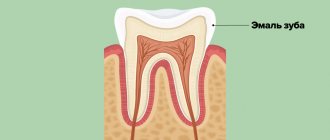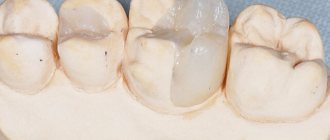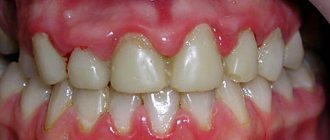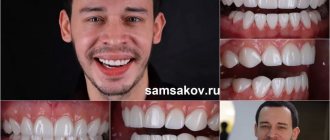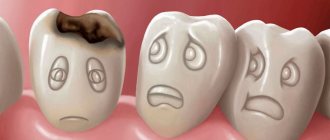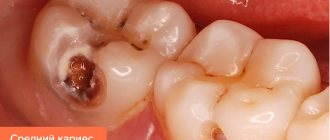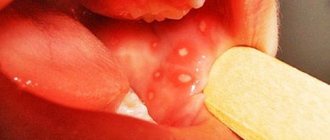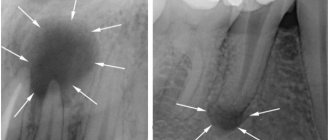Deep caries is the fourth and final stage of destruction and demineralization of hard tooth tissues. Looking at the photo of deep caries, you can immediately notice the presence of a carious hollow. From the outside it may seem small, but inside there is always significant destruction of dental tissue.
With deep caries, the carious cavity is separated from the pulp by only a narrow layer of dentin, which with further development of the disease can lead to the development of pulpitis, periodontitis or periostitis. Thus, the main task of the dentist is to preserve all the functions of the tooth and minimize the risk of developing these diseases.
Definition of the concept in dentistry
Deep caries is the last stage of the carious process occurring in the tooth, which is characterized by extensive damage not only to hard tissues, but also to the deep layers of dentin. In general, the concept of “deep caries” reflects the depth of the lesion.
Caries can be:
- primary - a consequence of untreated secondary caries;
- secondary (recurrent) - the occurrence of a carious process under a filling in a previously treated tooth.
Based on the sensation of pain and clinical examination, the disease is divided into 3 forms:
- Acute form. It is determined by the narrow entrance opening of the carious cavity and the wide base (during examination), as well as by descriptions of the patient’s sensations - reaction to food temperature and chemical irritants.
- Chronic form. It is characterized by a wide (funnel-shaped) inlet and a narrow base. The patient feels pain when the “hollow” is clogged with food and during examination with a probe by the dentist.
- Deep cervical caries. It is characterized by the development of demineralization of enamel tissue and the carious process in the cervical area of the tooth (near the gums).
According to the clinical course, caries is also divided into several forms:
- compensated,
- subcompensated,
- decompensated.
Clinical manifestations
Symptoms of deep caries, first of all, consist of a sharp toothache when exposed to thermal, chemical or mechanical stimuli. The pain is short-term and disappears after the stimulus is removed. If pieces of food remain in the cavity, the pain becomes aching and can last until the irritants are eliminated. If the carious cavity is extensive, the patient may develop an unpleasant putrid odor from the mouth. Caries under a filling can develop for years and is characterized by the absence of clinical manifestations. Painful sensations occur only when the dentin is destroyed to the bottom of the tooth.
Diagnostics
To make a diagnosis, diagnostics are carried out, which include:
- external inspection using a mirror;
- instrumental examination using a probe;
- voicing symptoms (complaints) by the patient;
- thermal diagnostics (checking the reaction to cold and hot);
- electroodontic diagnostics (testing the reaction to exposure to current);
- radiography (performed if the presence of secondary deep caries is suspected or to exclude it).
If upon examination significant damage (destruction) of the tooth crown is detected, expressed by the presence of a deep carious cavity and accompanied by pain during probing, then this confirms the presence of deep caries in the patient.
In the acute form, the carious cavity is filled with light, softened dentin. In chronic deep caries, the walls and bottom of the cavity are filled with a layer of dense pigmented dentin (from brown to black). Percussion of the tooth is not accompanied by pain.
WHEN SHOULD OLD FILLINGS BE CHANGED?
Replacing old fillings is a method of treating and preventing secondary caries. This makes it easier to prevent the disease from getting worse and treat it conservatively in one visit to a specialist. Therefore, old fillings that have stood for more than 5 years should be changed if:
- the tight fit of the filling to the tooth is broken, i.e. pieces of food get stuck between the material and the walls of the cavity, there is a high risk of damage to hard tissues;
- there is excess material and it “hangs” over the neighboring unit or gum, which causes a local inflammatory reaction on the gum, bleeding and the risk of destruction of the root system of the unit due to the accumulation of food and pathological microorganisms;
- abrasion of the filling has occurred, which over time leads to bite pathology and problems with the TMJ;
- The filling material did not restore the anatomy of the chewing surface, i.e. has changed the natural shape, and thus increases the risks of joint diseases;
- the aesthetics are impaired, especially the frontal group of teeth, which are visible when smiling;
It turns out that replacing fillings is important because of maintaining the health of teeth and gum tissue. If the attending physician considers it necessary to replace an outdated filling, you should agree for the sake of continued oral health.
What are the differences from other forms of the disease?
Deep caries is very similar to some forms of the disease, but there are still visible and invisible differences.
Difference from pulpitis
Pulpitis is a complication of advanced caries. The forms of the disease can be distinguished from each other by their characteristic symptoms:
- Defeat. With pulpitis, the nerve is affected; with caries, the nerve remains unharmed.
- Feelings of pain. With pulpitis, pain can occur spontaneously, even without exposure to irritants on the tooth. With caries, pain disappears along with the disappearance of irritants.
- Night sleep. With pulpitis, sleep can be disturbed due to severe pain; with caries, the tooth does not hurt at night.
Difference from average caries
The similarity between the two forms of the disease is that the patient in both forms feels pain from cold, sour or sweet foods. However, with average caries they go away within 1-2 minutes, with deep caries they last longer.
Medium caries is characterized by the fact that in this form the carious lesion does not affect the tooth pulp and does not cause inflammation of the nerve, as in deep caries.
Etiology
The medical history of deep caries may indicate the primary or secondary development of the disease. In the first case, it occurs due to the lack of professional treatment of the middle stage of caries, in the second - after tooth preparation (incorrect treatment, chipped filling). Otherwise, the factors stimulating the development of the disease are the same as for caries in general: poor hygiene, lack of necessary cleaning of hard-to-reach places, disturbances in pH levels, saliva composition, genetic predisposition.
In our clinic you can get a free dental consultation!
Stages of treatment
Treatment of deep caries is impossible without anesthesia (pain relief) and it takes place in several stages.
- Anesthesia. It is carried out using injection (infiltration or conduction) administration of an anesthetic substance.
- Drilling out a carious cavity using a drill. In this way, the specialist can reach and remove all affected areas of dentin, which is very important to prevent relapse under the filling.
- Treatment (disinfection) of the walls of the tooth and the bottom of the cavity.
- Installation of a therapeutic insulating pad and temporary or permanent filling.
- The final stage involves grinding and polishing the filling.
The following factors influence whether a filling will be installed - temporary or permanent:
- at what distance from the pulp is the carious cavity located;
- parameters of dentin, which separates the pulp from the tooth cavity;
- degree of pain.
If there is a high probability of inflammation developing in the pulp area, the dentist will place a temporary filling. And only if there are no complaints of pain and discomfort for several days, the patient will have the temporary filling replaced with a permanent one.
What is dental caries?
This pathology can be called, without exaggeration, “dental enemy of humanity No. 1.” This disease affects 93% of the world's population. It was found even in people who lived 5-6 thousand years ago, and today caries in adults is the cause of tooth loss in almost 90% of cases. Moreover, it leads not only to the formation of the well-known “holes”. Subsequently, when the pathological process begins to spread to the surrounding areas, this causes the appearance of periodontitis, and then complete destruction of the tooth, which requires the irreversible removal of its remains and root.
Deep caries of the front teeth. What are the differences in treatment?
Deep caries of the front teeth should be treated as carefully as possible so as not to burn the pulp. The main difficulty in treatment is:
- minimum thickness of all tooth tissues;
- inconvenient location of the cavity, if we are talking about caries located in the interdental space.
When infection penetrates into the pulp, pulpitis develops rapidly. A few hours is enough. The disease is accompanied by increasing pain. It needs to be treated immediately.
CLASSIFICATIONS OF SECONDARY CARIES
Secondary caries (according to ICD K02.8) is divided into 2 types, taking into account the location of the destruction:
- Superficial - destruction develops below the surface of the tooth, along the edges of the cavity;
- Internal - goes under the filling along the walls of the cavity along microcracks.
Also, sometimes residual caries, which has arisen due to poor-quality mechanical treatment of the cavity by the doctor, is added to the classification.
According to the rate of development of secondary caries:
- Spicy. Destruction of hard tissue structures and pathogenic microorganisms prevail over the protective mechanisms of the pulp chamber;
- Chronic. The rate of destructive processes slows down due to the formation of secondary dentin.
Also, a secondary carious process is distinguished:
- active;
- persisting.
CAUSES OF SECONDARY CARIES
There are many reasons that provoke the development of secondary carious pathology:
- Incomplete mechanical cleaning of the affected cavity. If all carious areas have not been eliminated, then the process can be resumed.
- Poorly performed medicinal treatment of the cavity before introducing the material. Because of this, the filling will not fit tightly, the tooth may crumble, and caries appears in the resulting cracks.
- Shrinkage of filling material. After some time, the filling may sag, causing secondary destruction of the tissue around it.
- Poor quality filling material.
- Violation of the structure of the material.
- Frequent consumption of carbohydrates.
- Poor oral hygiene.
- Exposure to enamel of high and low temperatures.
- Eating hard foods that damage fillings and hard tooth tissues.
Is it possible to treat deep caries of a wisdom tooth?
The patient can make the decision to remove a wisdom tooth if pain occurs on his own. But only a highly qualified dentist can make a verdict on its treatment.
Treatment of a carious "eight" is considered rational if it has a partial covering in the form of a hood of gum, as well as an antagonist - the third molar located on the opposite side.
Removal shown:
- with a horizontal tooth position;
- presence or absence of 1st and 2nd molars;
- impossibility of treatment due to incomplete opening of the mouth;
- displacement of teeth in a row due to wisdom teeth.
PREVENTIVE ACTIONS
To reduce the risk of pathology formation, it is important for patients to perform secondary prevention of caries:
- install composite inlays and crowns from modern materials;
- follow all the specialist’s recommendations during and after treatment;
- when identifying the first violations of the structure of the material, it is important to make an appointment with a doctor;
- come for preventive examinations once every six months, even without obvious complaints.
Compliance with all simple rules will make it possible to minimize the risk of a secondary process. It is important to find an experienced doctor to perform treatment. That is why, when choosing a clinic, you should pay attention to prices, patient reactions after an appointment, and the qualifications of doctors.
By making an appointment with us at West Dental, you make your choice to use the best specialists and high-tech equipment and perform treatment procedures with modern materials, so the occurrence of secondary pathology will be minimal.
Treatment of average caries in stages
Carious lesions that affect dentin are treated only in a dental clinic. Since at this stage the carious cavity is located in sensitive dentin, treatment is often carried out using local anesthesia.
Step-by-step treatment is carried out as follows:
- First, the dentist cleans the tooth surface from soft and hard deposits.
- After cleaning, he selects the shade of the material for the future filling, taking into account the natural color of the patient’s teeth.
- The next step is an injection with an anesthetic. To make the injection sensation less painful and uncomfortable, the gums are pre-treated with a gel with an anesthetic effect.
- Using a special latex plate, the diseased tooth is isolated from others, ensuring dryness and cleanliness in the desired area, which increases the effectiveness of treatment.
- An important step in the treatment of average caries is the preparation of the cavity affected by caries. It is leveled by removing the hanging edges of tooth enamel, removing the pigmented and softened layer of dentin, and creating the optimal shape for installing a filling.
- The formed cavity is washed, treated with antiseptic solutions and dried.
- The next step is to etch the walls with acid and apply an adhesive composition to them, which ensures the best adhesion of the filling material to the natural tissues of the tooth.
- After applying the adhesive, an insulating gasket is installed. It will prevent the negative impact of the filling on the tooth pulp. If inflammation is present, a pad with a therapeutic effect may be required.
- And finally, the filling composite is applied in layers. Each layer is illuminated with a special lamp for hardening.
- When the filling is installed, it must be aligned in such a way that when the jaws are closed, the bite is not disturbed. To do this, the dentist grinds and adjusts the surface of the filling.
Upon completion of treatment, the doctor gives recommendations on oral care, prevention of re-development of caries, and selects hygiene products taking into account individual characteristics.
In most cases, to cure average caries of one tooth, a one-time visit to the doctor is enough.
Causes
Caries can be either an independent disease or a concomitant one. The development of caries is promoted by:
- decreased general and local immunity;
- problems with the gastrointestinal tract;
- non-compliance with the recommended diet;
- unfavorable environmental conditions;
- low quality of drinking water;
- work in hazardous industries involving inhalation of acid fumes;
- insufficient oral hygiene (especially ignoring hard-to-reach places when brushing teeth);
- individual characteristics inherent at the genetic level;
- thinning of enamel associated with impaired mineral metabolism.
Why is this necessary?
- Preservation, not restoration of health. Even at the initial stage, caries is associated with varying degrees of destruction of dental tissue. Of course, the dentist will restore the tooth and form a filling, which will be installed in place of the missing fragment. But, in any case, the filling serves only as an analogue, a more or less effective replacement for lost dental tissue. Prevention does not allow the disease itself to develop. That is, it preserves the integrity of the natural structure of the tooth, eliminating the need to use artificial substitutes.
- Prevention is easier than cure. Treatment of carious lesions, especially in cases of large-scale spread, can be quite time-consuming. And at the same time, no one can guarantee that the disease will not appear again, on another tooth. Regular prophylaxis is much faster. This procedure only takes about an hour, does not require complex dental procedures, and should be performed on average only twice a year.
- Finally, prevention is cheaper than cure. From a financial perspective, caries prevention is also much cheaper than a full course of treatment. Therefore, by carefully monitoring the condition of your oral cavity and preventing the development of disease, you not only take care of your health, but also save money!
